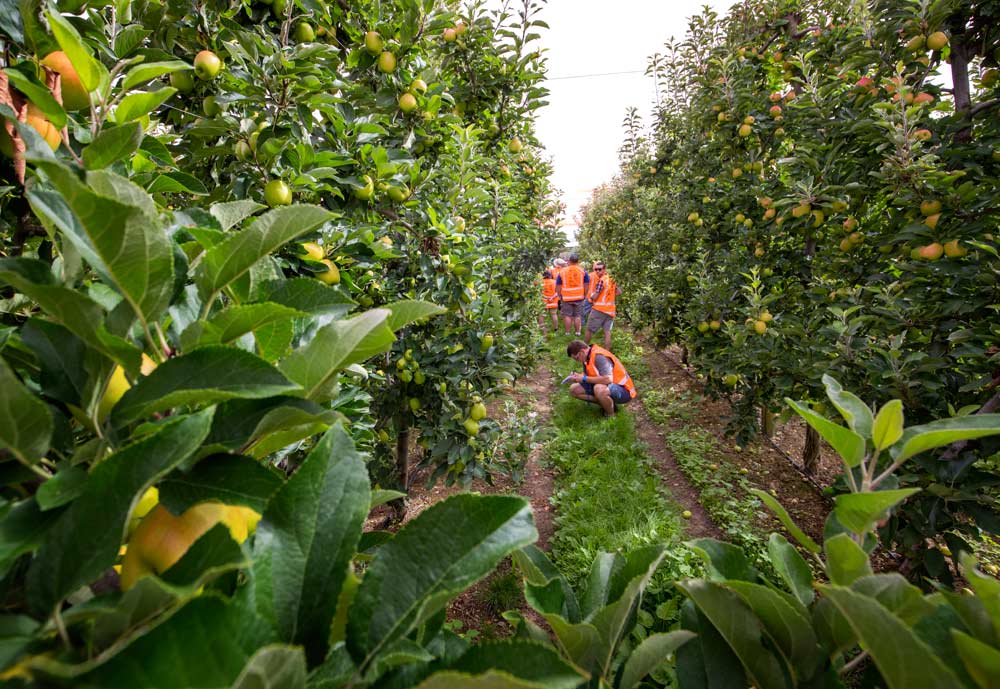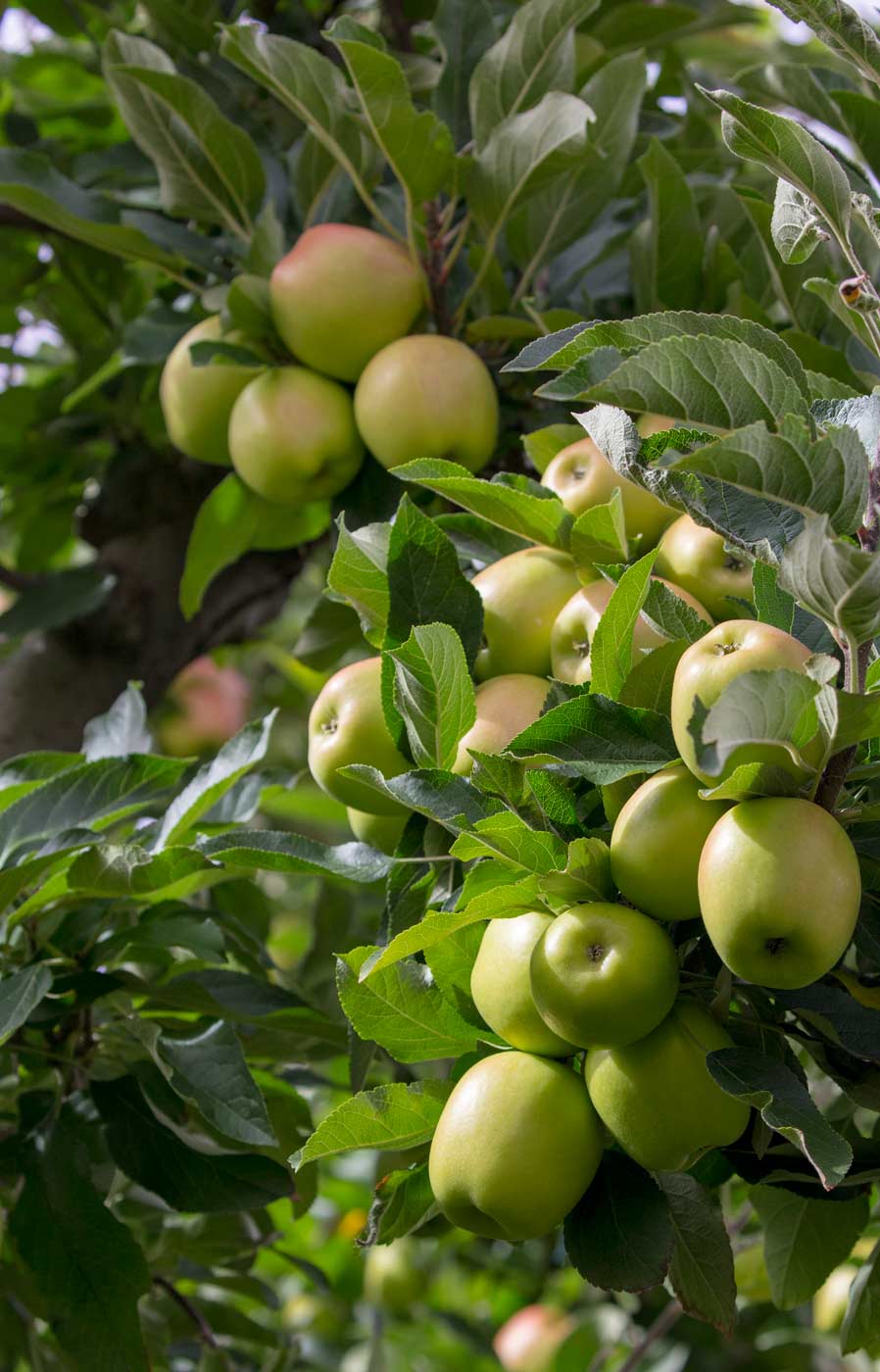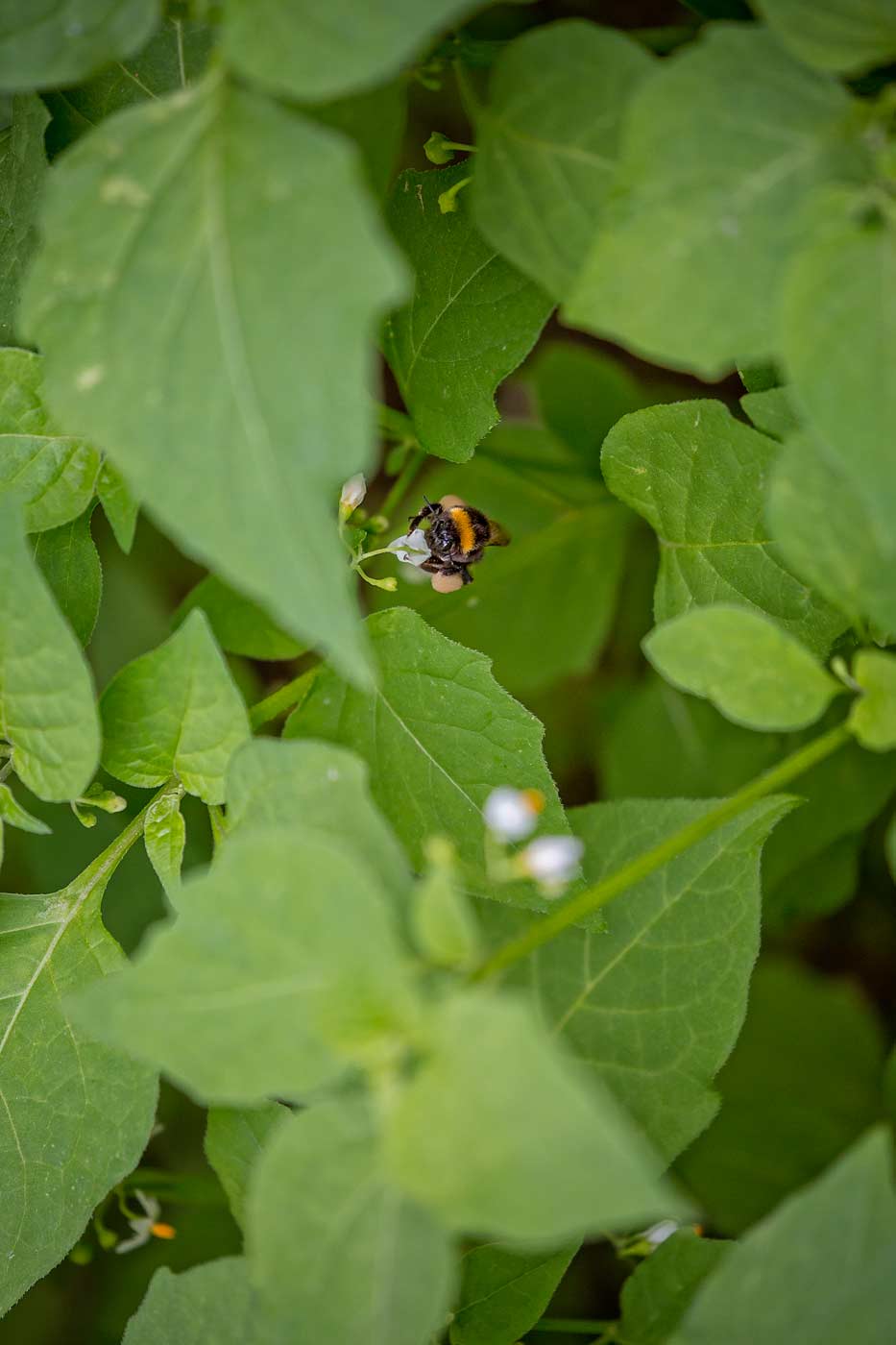
Josh Heinicke, from Wenatchee, Washington, takes notes while listening to Dean Rainham (not pictured) talk about improving the health of this Jazz block during the 2018 International Fruit Tree Association New Zealand Study Tour in February 2018, in the Nelson area. Rainham said closely monitoring the health of the trees through leaf samples saved this block. (TJ Mullinax/Good Fruit Grower)
Aaron Drummond was ready to give up on a 35-acre Jazz apple block that was underperforming at his Fairfield Orchards near Nelson, New Zealand, when he hired a consultant to assess the situation — a final attempt to avoid ripping it out.
The trees, mostly on Malling 9 with some Geneva 202 rootstocks, performed reasonably well the first few years, when they were young. “But as the trees developed, we’ve run into problems,” Drummond said.
The effort to save the orchard meant a return to some basics, and the progress has been substantial enough to be labeled “from good to great” at the International Fruit Tree Association’s study tour in February.
“We’ve taken steps to swing it back the other way, but probably still may have a little ways to go,” Drummond said.

Dean Rainham, from AgFirst during the 2018 International Fruit Tree Association New Zealand Study Tour. (TJ Mullinax/Good Fruit Grower)
Horticultural consultant Dean Rainham of AgFirst shared his experiences with the block during the tour.
When approached about the problem in 2014, Rainham noted the biggest problem was determining why the orchard produced smaller fruit.
“The fruit was growing nicely at normal rates through till about Christmastime, then it would stall and plateau and not finish the crop off,” he said. “We needed to go back to the basics.”
Soil tests showed the orchard was lacking in key cation nutrients, particularly potassium, magnesium and calcium.
But lifting pH takes time for the lime to work, he said. Drummond and Rainham applied not just solid fertilizer but fertigated potassium through the drip line in the winter. They then leaf tested and monitored intensively through the first season, with the first leaf tests in October and monthly thereafter.
“We were monitoring closely the nutrition of the trees to ensure we’re not, one, overdoing a particular nutrient and creating other imbalances, but also to ascertain which nutrient in particular was most limiting,” he said. “It seemed evident that potassium was the most limiting nutrient on the orchard.”
Rainham also noticed issues with vigor and blotch and had an eye on calcium levels, too. “It was counterintuitive to say, ‘Let’s put more potassium on a calcium problem orchard,’ but in doing so, what we did was create a healthier tree, a better functioning tree.”
Focusing on potassium also lowered the nitrogen to potassium ratio, driving better color development in the fruit.
All the while, he said, they were keeping an eye on calcium and magnesium, which was starting to trend down a little. Rainham said they topped mainly with foliar magnesium, but also dolomite lime in a herbicide strip.
The result: balanced calcium, magnesium and potassium levels in the soil.

Improving soil nutrition levels helped reinvigorate this Jazz block in Fairfield Orchard, resulting in healthier trees and plant growth on the orchard floor. (TJ Mullinax/Good Fruit Grower)
Water and fruit size
The orchard was once a cattle farm, with clay soil throughout and a sandy swamp in the back end where drainage issues have cropped up, Drummond said. So, soil moisture monitoring became imperative.
Extra soil moisture monitors were installed in all five blocks of the orchard and checked each week to make adjustments to irrigation management.
The results prompted Drummond to go from irrigating three times per week to irrigating daily, sometimes for only 45 minutes at a time. They also divided the orchard into more blocks to better improve irrigation when it became apparent that Drummond was losing pressure at ends of lines.
The crew also performed regular fruit size monitoring to ascertain why fruit weren’t growing.
The company already performed some benchmark monitoring, measuring 100 fruit randomly throughout the orchard three times during the season. This added monitoring involved measuring the size of 20 pieces of fruit — the same pieces of fruit — each week through the season.
The 20 apples hung from 10 trees on one side of the orchard and 10 trees on the other side, all randomly selected at shoulder height. They tagged the fruit after hand-thinning and monitored each week.
By returning to some basics, fruit size has increased 15 percent and yields have increased to a forecasted 90 metric tons per hectare this year. The kicker: For every $10,000 Drummond spent, he saw a $160,000 profit, Rainham said.
“It’s all these little incremental changes in what I call the foundations of the orchard — soil, nutrients, water — that made a massive difference in this orchard,” he said. “Yes, you’ve got to get the right crop load, yes, you’ve got to get your disease management and all those other orchard management techniques. But getting the foundation right really set the orchard up to the right result.” •
Bonus credit for benchmarking
Knowledge is power, and improved knowledge and performance come from benchmarking — comparing products and horticultural methods with those of the most successful companies in your field to try to improve your own performance.
That’s the take of Ross Wilson, an AgFirst horticultural consultant who delivered a talk during the International Fruit Tree Association annual conference in Napier, New Zealand, in February.
Wilson presented several case studies where benchmarking and data accumulation aided growers, including the story of Drummond’s Jazz orchard.
Benchmarking enabled Robert Green, the 2014 farmer of the year in Australia, to destroy some myths and create new paradigms about apple growing there, Wilson said.
“The myth was that a 100 tonnes per hectare of good fruit was impossible in Australia. It’s too hot. We don’t have enough water. It’s just a microclimate, we will never do it,” he said.
Benchmarking showed that the sun was the most limiting factor to yield — and Australia has heaps of sun. “If you can supply the tree with the right amounts of heat, why shouldn’t you be able to do 100 tonnes?” he asked.

Healthy Jazz apples at Fairfield Orchard in the Nelson area of New Zealand, seen in February during the 2018 International Fruit Tree Association study tour. (TJ Mullinax/Good Fruit Grower)
Green achieved that in a Rosy Glow block, he said, and now 100 tonnes (1 metric ton, or tonne, is a little more than 1 U.S. ton) is the new norm in that country.
Another grower faced exorbitant labor costs, at 77 cents per kilogram of fruit, compared to the industry average of 32 cents. The grower relied on backpackers for labor and paid them an hourly rate.
“They were only picking 20 tonnes per hectare. Their efficiency was poor in terms of what they’re growing, and the labor demographic they were using and the system they were using was very inefficient,” he said.
The grower changed his labor source to seasonal Pacific islanders who want to work, work hard and can make a lot of money, Wilson said. The grower also switched to paying piece rate as much as possible.
Since the study, the industry average has gone from 32 cents to 40 cents. The grower’s cost per kilogram fell from 77 cents to 16 cents, and the grower’s overall labor costs now stand just 8 cents over the industry average.
“It’s a really good example of how that business used benchmarking data to make some huge changes,” he said.
But Wilson offered a few caveats about benchmarking and some tips for proper data collection:
—Make it easy to collect.
—Keep it clean with good QA systems.
—Make sure the data set is large enough to be representative, and if it’s not, don’t use it.
—Make the reporting graphic and simple.
—Do not collect data for data’s sake. Identify the use.
—Maintain confidentiality and trust.
—by Shannon Dininny / photos by TJ Mullinax






Leave A Comment